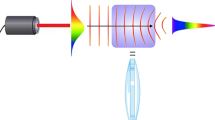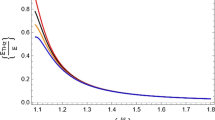Abstract
Based on Kirchhoff’s transformation a mathematical expression was derived to reduce the temperature distribution in a double-end-pumping configuration utilizing an annular intensity profile. The critical parameters affecting the laser rod temperature distribution, such as the cooling temperature, waist radii, and pump power were theoretically analyzed and simulated using the MATLAB software. The results revealed that with annular pumping; a reduction in temperature of approximately 28.58% was obtained compared to the top-hat intensity profile. In the present study, the derived expression offers an exact solution for thermal mitigation for different cavity configurations and laser parameters.






Similar content being viewed by others
References
X. Wu, L. Tang, C.L. Hardin, C. Dames, Y. Kodera, J.E. Garay, Thermal conductivity and management in laser gain materials: a nano/microstructural perspective. J. Appl. Phys. (2022). https://doi.org/10.1063/5.0073507
M. Mojahedi, H. Shekoohinejad, Thermal stress analysis of a continuous and pulsed end-pumped Nd:YAG rod crystal using non-classic conduction heat transfer theory. Braz. J. Phys. 48(1), 46–60 (2018). https://doi.org/10.1007/s13538-017-0538-4
Z. Li, X. Huai, W. Li, A study of the axisymmetric thermal strain in a laser rod with longitudinal temperature rise. Appl. Therm. Eng. 29(14–15), 2927–2934 (2009). https://doi.org/10.1016/j.applthermaleng.2009.02.017
N.M. Al-Hosiny, A.A. El-Maaref, R.M. El-Agmy, Mitigation of thermal effects in end pumping of Nd:YAG and composite YAG/Nd:YAG laser crystals, modelling and experiments. Tech. Phys. 66(12), 1341–1347 (2021). https://doi.org/10.21883/jtf.2021.08.51103.38-21
J. Cui, X. Liu, L. He, S. Zhang, J. Yang, Investigation of the transient thermal profile of an anisotropic crystal in a pulsed and end-pumped laser. J. Mod. Opt. 65(16), 1847–1854 (2018). https://doi.org/10.1080/09500340.2018.1455921
M.H. Moghtader Dindarlu, M.K. Tehrani, H. Saghafifar, A. Maleki, Analytical model for temperature distribution of an end diode-pumped laser slab with Robin boundary conditions by Green’s function method. Laser. Phys. 26(5), 55001 (2016). https://doi.org/10.1088/1054-660X/26/5/055001
F. Kalantarifard, H. Nadgaran, P. Elahi, The analytical and numerical investigation of thermo-optic effects in double-end-pumped solid state lasers. Int. J. Phys. Sci. 4(6), 385–389 (2009)
J.W. Kim, D.J. Kim, S.H. Noh, S.M. Ahn, Influence of a ring-shaped pump beam on temperature distribution and thermal lensing in end-pumped solid state lasers. Optics Express 25(13), 14668 (2017). https://doi.org/10.1364/oe.25.014668
Y. Wang, Q. Wang, Q. Na, Y. Zhang, M. Gao, M. Zhang, Analysis of the thermal effect in diode end-pumped Er:YAG lasers by using Finite Element Method (2018) p. 67. https://doi.org/10.1117/12.2295879
M. Y. Ghadban, K. S. Shibib, M. J. Abdulrazzaq, Analytical model of transient thermal effects in microchip laser crystal, in AIP Conference Proceedings, vol. 2213 (2020). https://doi.org/10.1063/5.0000277
D. Lin, W. Andrew Clarkson, End-pumped Nd:YVO_4 laser with reduced thermal lensing via the use of a ring-shaped pump beam. Opt. Lett. 42(15), 2910 (2017). https://doi.org/10.1364/ol.42.002910
M. Sabaeian, F.S. Jalil-Abadi, M.M. Rezaee, A. Motazedian, M. Shahzadeh, Temperature distribution in a Gaussian end-pumped nonlinear KTP crystal: the temperature dependence of thermal conductivity and radiation boundary condition. Braz. J. Phys. 45(1), 1–9 (2015). https://doi.org/10.1007/s13538-014-0291-x
Y. Sato, T. Taira, Thermo-optical and -mechanical parameters of Nd:GdVO4 and Nd:YVO4 in Conf. Lasers Electro-Optics, 2007, CLEO 2007, no. June 2007 (2007), pp. 4–6. https://doi.org/10.1109/CLEO.2007.4453701
M.J. AbdulRazzaq, K.S. Shibib, S.I. Younis, Temperature distribution and stress analysis of end pumped lasers under Gaussian pump profile. Opt. Quantum Electron. (2020). https://doi.org/10.1007/s11082-020-02499-y
M.J. AbdulRazzaq, A.Z. Mohammed, A.K. Abass, K.S. Shibib, A new approach to evaluate temperature distribution and stress fracture within solid state lasers. Opt. Quantum Electron. 51(9), 294 (2019). https://doi.org/10.1007/s11082-019-2012-8
M.J. Abdul Razzaq, K.A. Hubeatir, Analysis of thermal effects within cylindrical shape solid-state laser rod. Mater. Sci. Forum 1002, 264–272 (2020). https://doi.org/10.4028/www.scientific.net/MSF.1002.264
H.M. Ahmed, M.J.A. Razzaq, A.K. Abass, Numerical thermal model of diode double-end-pumped solid state lasers. Int. J. Nanoelectron. Mater. 11(4), 473–480 (2018)
L. Cini, J.I. Mackenzie, Analytical thermal model for end-pumped solid-state lasers. Appl. Phys. B Lasers Opt. (2017). https://doi.org/10.1007/s00340-017-6848-y
Author information
Authors and Affiliations
Corresponding author
Ethics declarations
Conflicts of interest
The authors declare that there are no conflict of interest.
Additional information
Publisher's Note
Springer Nature remains neutral with regard to jurisdictional claims in published maps and institutional affiliations.
Appendix A: Calculations of temperature distribution utilizing annular-beam profile in double end-pumped lasers configuration
Appendix A: Calculations of temperature distribution utilizing annular-beam profile in double end-pumped lasers configuration
The steady-state heat conductance equation described by Eq. (1) can be simplified by using the assumptions of an axisymmetric pump profile and isotropic cooling in the z-plane and it could be written as:
Applying Kirchhoff transformation in term of function U, Eq. (15) can be solved as follows:
This leads to
Substituting Eq. (17) into Eq. (16), and by applying differentiation chain rule, Eq. (16) transformed into the linear form:
In case of annular-beam pumping temperature distribution can be classified to three regions, for the inner region, \(0 \le r \le r_{1}\) Equation (18) can be written as
let \(\frac{{{\text{d}}U_{1} \left( {r,\;z} \right)}}{{{\text{d}}r}} = w_{1} \left( r \right)\) and \(\frac{{{\text{d}}^{2} U_{1} \left( {r,\;z} \right)}}{{{\text{d}}r^{2} }} = \frac{{{\text{d}}w_{1} \left( r \right)}}{{{\text{d}}r}}\). Multiplying by r and Substituting \({1} = \frac{{{\text{d}}r}}{{{\text{d}}r}}\), that gives
Equation (20) can be written as
And by applying integration into Eq. (21), that gives
where A is an integration constant. By using another integration,
Then the temperature equation would be
For the second region, \(r_{1} < r \le r_{2}\),Eq. (18) becomes
In the same way, this equation was solved and the result was
And by using Eq. (24), temperature equation was obtained
For the last region,\(r_{2} < r \le { }r_{0}\), Eq. (18) becomes
Using the same steps, this equation was solved to obtain
Equation (24) utilized to obtain temperature equation
A, B, D, E, G, and H are integration constants, that can be found by using a boundary conditions.
For symmetry reasons, the heat flux in r direction must be zero at the center of the rod, which means:
Substitute Eq. (17) into Eq. (32), the first boundary condition written as
And by using Eq. (A-11), the first integration constant obtained
On the other hand, the boundary condition at the rod surface \(\left(r={r}_{0}\right)\) can be written as:
Substituting Eqs. (30) and (31) into Eq. (35) that lead to
The other boundary conditions at \(r = r_{1}\) and \(r = r_{2}\) where
That gives
And
Which gives
And for the other condition, at \(r = r_{2}\)
That give:
\(B,D,E,G,\mathrm{and} H\) can be found by solving Eqs. (36), (38), (40), (43), and (44)
Substitute Eqs. (45), (46), (47), (48), and (49) into the Eqs. (25), (28), and (31) to obtain
Rights and permissions
Springer Nature or its licensor (e.g. a society or other partner) holds exclusive rights to this article under a publishing agreement with the author(s) or other rightsholder(s); author self-archiving of the accepted manuscript version of this article is solely governed by the terms of such publishing agreement and applicable law.
About this article
Cite this article
Khazal, Z.A., AbdulRazzaq, M.J. & Ibrahim, R.K. Reducing temperature distribution in solid-state lasers utilizing annular beam profile: modeling and simulation. J Opt 53, 518–527 (2024). https://doi.org/10.1007/s12596-023-01168-z
Received:
Accepted:
Published:
Issue Date:
DOI: https://doi.org/10.1007/s12596-023-01168-z




